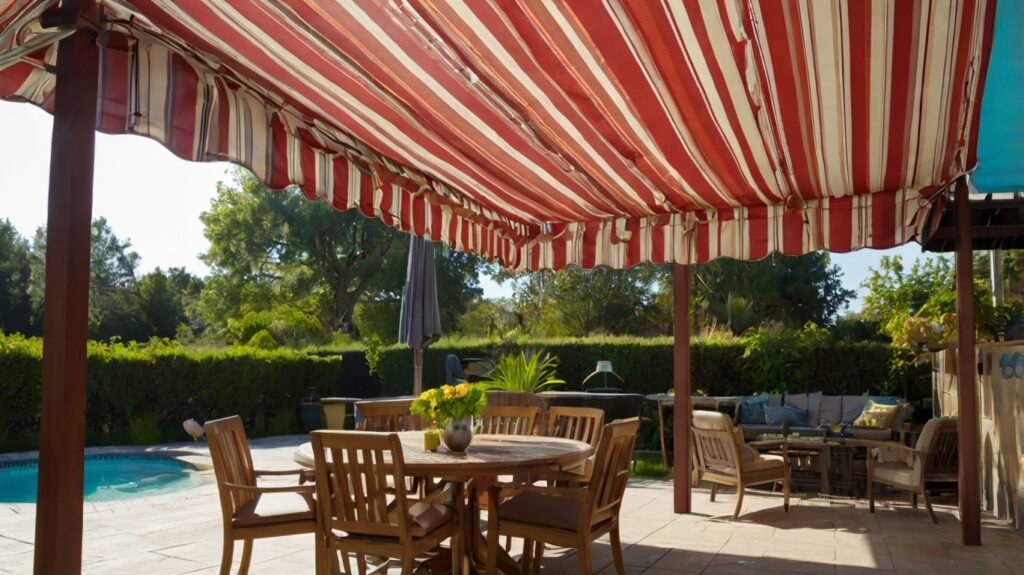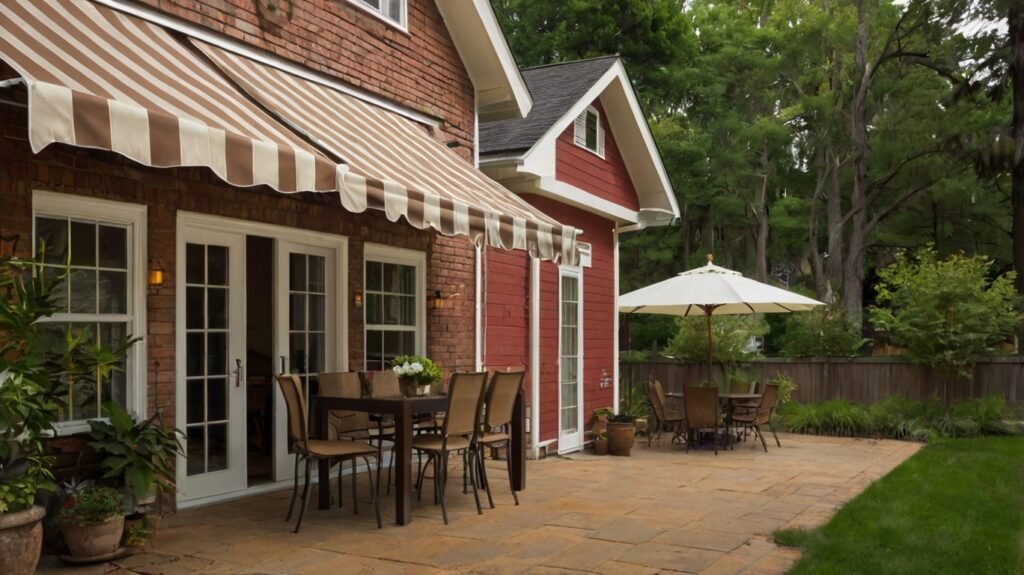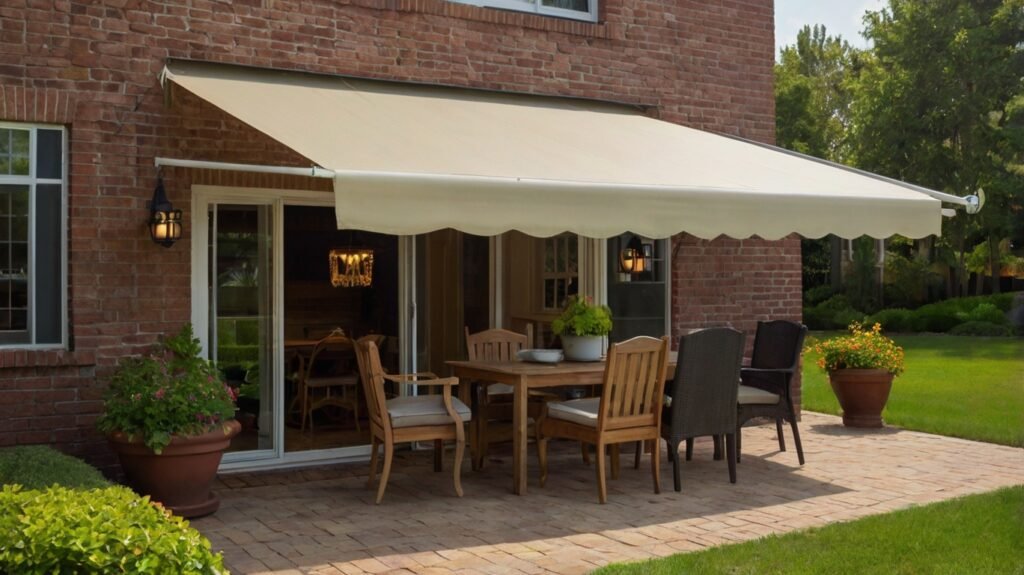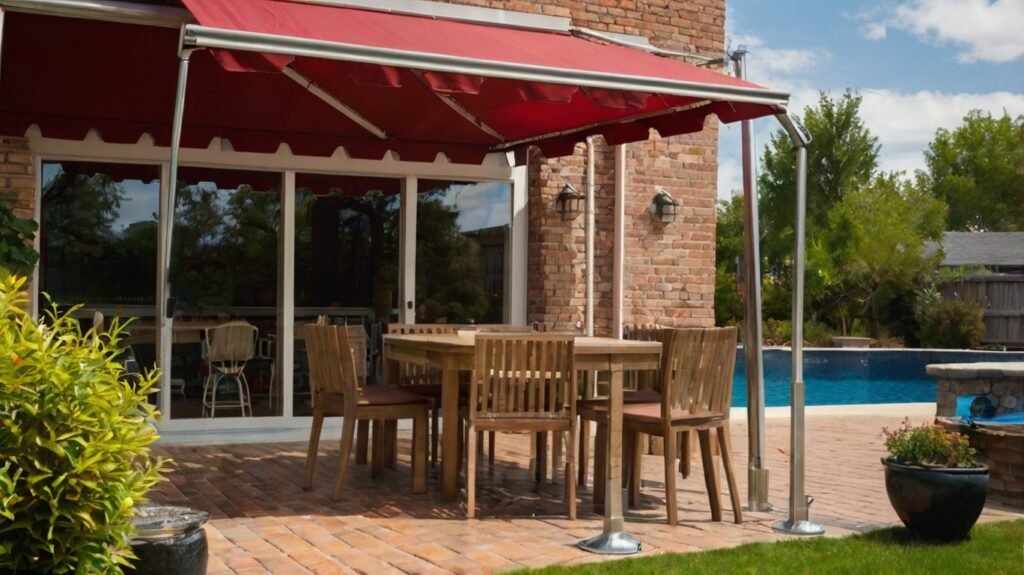Introduction
G’day, mates! Is your trusty awning looking a bit worse for wear lately? You’re not alone. Many Aussie homeowners find themselves squinting at their awnings, wondering if it’s time for a fabric facelift. Just like a faithful old ute that’s seen better days, your awning fabric might be sending you signals that it’s ready for retirement.
In this comprehensive guide, we’ll explore the ten telltale signs that your awning fabric is crying out for replacement. We’ll dive deep into each sign, giving you the lowdown on what to look for and why it matters. By the end of this article, you’ll be an awning expert, ready to make the call on whether your outdoor shade solution needs a refresh.
So, grab a cuppa and let’s get stuck into it, shall we?
Sign #1: Fading Colours
Remember when your awning was the talk of the neighbourhood, with its vibrant hues that perfectly complemented your home’s exterior? If those once-striking colours are now looking more washed out than a pair of old boardies, it might be time to consider a replacement.
Fading colours aren’t just a cosmetic issue. They’re like the greying hair of awning fabrics – a sign of ageing and reduced effectiveness. As the colour fades, so does the fabric’s ability to protect you from harmful UV rays.
“Colour fading in awning fabrics is nature’s way of telling you that the material is breaking down at a molecular level,” says Sarah Thompson, a textile expert from Melbourne. “It’s not just about looks; it’s about the integrity of the fabric itself.”
To check for fading, compare the top of your awning (the part most exposed to sunlight) with the underside or any areas that are usually folded away. If there’s a stark difference, your awning is waving the white flag of surrender to the Aussie sun.

Sign #2: Visible Wear and Tear
Just like your favourite pair of thongs eventually show signs of wear, your awning fabric isn’t immune to the ravages of time and weather. Visible wear and tear are clear indicators that your awning fabric is on its last legs.
What should you be looking for? Keep an eye out for:
- Small holes or tears
- Frayed edges
- Thin spots in the fabric
- Stress marks around seams and fasteners
These issues aren’t just unsightly; they’re the precursors to bigger problems. A small hole today could be a gaping tear tomorrow, especially when a good southerly blows through. And let’s face it, an awning full of holes is about as useful as a screen door on a submarine.
Don’t ignore these visible signs of wear. They’re your awning’s way of telling you it’s struggling to keep up with the demands of outdoor life. Addressing these issues promptly can save you from more significant headaches (and expenses) down the track.
Sign #3: Water Pooling
Picture this: it’s bucketing down outside, and instead of water sliding off your awning like a surfer on a wave, it’s collecting in little pools on top. If this scenario sounds familiar, you’ve got a water pooling problem on your hands.
Water pooling is more than just a minor inconvenience. It’s like having a ticking time bomb on your patio. Here’s why:
- Weight stress: All that collected water puts extra weight on your awning structure, potentially leading to damage or collapse.
- Fabric stretching: The weight of the water can cause the fabric to stretch and sag, creating even more areas for water to collect.
- Mould and mildew: Stagnant water is a breeding ground for mould and mildew, which can weaken the fabric and create health hazards.
“Water pooling is one of the most common issues we see with older awnings,” notes Tom O’Brien, a seasoned awning installer from Brisbane. “It’s a clear sign that the fabric has lost its tension and shape-holding properties.”
If you find yourself regularly pushing up on your awning to remove collected water after rain, it’s time to start shopping for a replacement. Your awning should be shedding water, not hoarding it like a camel preparing for a trek through the Simpson Desert.

Sign #4: Mould and Mildew Growth
In the land of Oz, where humidity can be as high as a kookaburra’s laugh, mould and mildew are unwelcome guests that love to crash the party on your awning. If you’re spotting fuzzy patches or discoloured areas on your awning fabric, you’ve got a mouldy situation on your hands.
Mould and mildew aren’t just unsightly – they’re like uninvited house guests that overstay their welcome and eat all your bikkies. These fungal freeloaders can:
- Weaken the fabric structure
- Create unpleasant odours
- Pose health risks, especially for those with allergies or respiratory issues
- Spread to other parts of your outdoor area
While a bit of mould might seem harmless at first, it’s a slippery slope. Once these fungi get a foothold, they can spread faster than gossip at a barbie. And trying to clean severe mould growth is often a losing battle, akin to trying to bail out the Titanic with a teacup.
If you’re constantly battling the green and black spots on your awning, it might be time to throw in the towel (or in this case, the awning) and opt for a fresh start with new, mould-resistant fabric.
Sign #5: Reduced Sun Protection
Let’s face it, in Australia, the sun is about as subtle as a kangaroo in a china shop. Our harsh UV rays can turn a pleasant outdoor gathering into a scene from “Mad Max” faster than you can say “slip, slop, slap”. That’s why your awning’s sun protection capabilities are crucial.
If you’re noticing that your outdoor area is getting hotter or brighter than it used to be under your awning, it’s a sign that the fabric’s sun protection properties are waning. This reduced effectiveness can happen due to:
- Breakdown of UV-resistant coatings
- Thinning of the fabric
- Loss of colour (remember our chat about fading?)
To test your awning’s sun protection, try this simple trick: on a sunny day, stand under your awning and look up. If you can see pinpricks of light coming through the fabric (outside of the seams), your awning is letting in more UV rays than it should.
“An awning that’s lost its sun protection is like sunscreen that’s past its use-by date,” explains Dr. Lisa Chen, a dermatologist from Sydney. “It might look like it’s doing the job, but you’re not getting the protection you need.”
Don’t let your awning’s reduced sun protection turn your patio into a frying pan. If you’re feeling the heat more than you used to, it might be time to invest in new awning fabric that can stand up to our fierce Aussie sun.
Sign #6: Sagging Fabric
A sagging awning is about as appealing as a deflated pavlova at a Christmas lunch. If your once-taut awning is starting to look more like a hammock, it’s sending you a clear message that it’s ready for retirement.
Sagging fabric isn’t just an eyesore; it’s a functional issue that can lead to a host of problems:
- Water pooling: Remember our chat about water collection? Sagging fabric is often the culprit.
- Reduced wind resistance: A slack awning is more likely to flap in the wind, causing noise and potential damage.
- Uneven sun protection: Sagging areas may let in more sunlight, defeating the purpose of your awning.
- Stress on the frame: The uneven distribution of tension can put unnecessary stress on your awning’s frame.
You might be tempted to tighten the fabric yourself, but that’s often a temporary fix at best. It’s like trying to smooth out the wrinkles on an old shirt – you might make it look better for a while, but the problem will soon return.
If your awning is starting to resemble a droopy dog’s ear rather than a crisp, flat surface, it’s probably time to consider new fabric that can maintain its shape and tension.
Sign #7: Difficulty in Retracting
Is operating your retractable awning turning into a workout session that rivals your attempts to open a stubborn jar of Vegemite? If extending or retracting your awning has become a Herculean task, it might be a sign that your fabric needs replacing.
Difficulty in retracting can stem from several fabric-related issues:
- Fabric that’s stretched out of shape
- Accumulation of dirt and debris in the mechanism
- Tears or fraying that catch in the rollers
While sometimes the problem lies with the mechanical parts, often it’s the fabric itself causing the grief. Worn or damaged fabric can put extra strain on the retraction mechanism, leading to a vicious cycle of wear and tear.
“A smooth-running awning should be as easy to operate as flicking on the barbie,” says Mike Foster, an awning technician from Perth. “If you’re breaking a sweat just trying to roll it up, something’s not right.”
Don’t let your awning turn into a daily wrestling match. If you find yourself grunting and groaning every time you try to retract it, it might be time to wave goodbye to the old fabric and welcome a new, smooth-operating replacement.

Sign #8: Fraying Edges
Fraying edges on your awning fabric are like split ends on your hair – they’re unsightly, hard to ignore, and a clear sign that some maintenance is overdue. But while a trim might fix your hair, fraying awning edges often signal the need for a complete fabric replacement.
Fraying typically starts at the edges and seams of your awning, where the fabric experiences the most stress. It’s not just a cosmetic issue; fraying can lead to:
- Reduced water resistance as the fabric’s edges become compromised
- Weakened structural integrity, potentially leading to tears
- Increased likelihood of further damage during wind or storms
You might be tempted to trim or patch the frayed areas, but that’s like putting a band-aid on a broken arm. It might look better temporarily, but it doesn’t address the underlying issue of fabric degradation.
If your awning’s edges are starting to resemble the fringe on a 1970s jacket, it’s probably time to consider new fabric that can provide clean, strong edges and renewed protection for your outdoor space.
Sign #9: Outdated Style
Let’s be honest, fashion isn’t just for your wardrobe. Your home’s exterior, including your awning, makes a statement about your style. If your awning fabric is looking more dated than a mullet at a modern music festival, it might be time for an update.
Style considerations for your awning include:
- Colour coordination with your home’s exterior
- Patterns that complement your outdoor décor
- Fabric types that suit current trends and your personal style
While functionality is key, there’s no reason your awning can’t be a stunning feature of your outdoor area. A stylish awning can:
- Enhance your home’s curb appeal
- Create a cohesive look for your outdoor living space
- Reflect your personal taste and lifestyle
“An outdated awning can really age a home’s appearance,” observes Emma Watson, an interior designer from Adelaide. “Updating your awning fabric is like giving your house a mini facelift – it can take years off its appearance.”
If your awning fabric is stuck in a time warp while the rest of your home has moved with the times, consider it a sign. A fabric update can breathe new life into your outdoor area and bring your home’s exterior bang up to date.
Sign #10: Age of the Awning
Last but not least, let’s talk about the elephant in the room – or should I say, the old timer on your patio. The age of your awning fabric is a crucial factor in determining whether it’s time for a replacement.
Even the highest quality awning fabrics have a limited lifespan. On average, you can expect a good quality awning fabric to last:
- 5-8 years for basic fabrics
- 8-12 years for mid-range fabrics
- 12-15 years for top-of-the-line fabrics
These are general guidelines, of course. Your awning’s lifespan can be shorter or longer depending on factors like:
- Local climate (hello, harsh Aussie sun!)
- Frequency of use
- Maintenance and care
If your awning fabric is pushing past these age ranges, it’s like driving an old car – you might be able to keep it running with increased maintenance, but at some point, the cost and effort outweigh the benefits of simply replacing it.
“Age is more than just a number when it comes to awning fabrics,” explains James Lee, a materials scientist from the University of Queensland. “Even if it looks okay, an older fabric may have degraded UV protection and water resistance that aren’t visible to the naked eye.”
If you can’t remember when you last replaced your awning fabric, or if you know it’s been well over a decade, consider it a sign. Investing in new fabric can provide you with improved performance, updated style, and peace of mind.
Conclusion
Well, there you have it, folks – the ten signs that it’s time to bid farewell to your old awning fabric and welcome a fresh new look. From fading colours to fraying edges, water pooling to waning sun protection, these signs are your awning’s way of waving a white flag and asking for a well-deserved retirement.
Remember, your awning is more than just a bit of shade – it’s an investment in your home’s comfort, style, and value. Keeping it in top nick isn’t just about aesthetics; it’s about ensuring your outdoor area remains a safe, comfortable, and inviting space for you and your loved ones.
Don’t wait until your awning is on its last legs before considering a replacement. By being proactive and addressing these signs early, you can avoid more significant issues down the track and keep your outdoor area looking schmick all year round.
So, next time you’re out in the yard, take a good squiz at your awning. If you spot any of these signs, it might be time to start shopping for some new fabric. Your future self (and your home) will thank you for it!
Top Tips for Awning Fabric Replacement
- Do your research: Look into different fabric types and their properties to find the best fit for your climate and needs.
- Consider professional installation: While DIY can be tempting, professional installation ensures your new fabric is fitted correctly.
- Don’t skimp on quality: Investing in higher quality fabric can save you money in the long run through increased durability and longevity.
- Match your home’s style: Choose a fabric colour and pattern that complements your home’s exterior for a cohesive look.
- Think about functionality: Consider factors like UV protection, water resistance, and ease of cleaning when selecting your new fabric.
- Plan for the future: Choose a style that you’ll be happy with for years to come, not just what’s trendy right now.
- Get multiple quotes: Shop around and get quotes from different suppliers to ensure you’re getting a fair deal.
- Check warranties: Look into the warranties offered on different fabrics and installations.
- Consider energy efficiency: Some awning fabrics can help reduce your cooling costs by blocking out heat.
- Don’t forget about maintenance: Ask about care instructions for your new fabric to ensure it lasts as long as possible.
FAQs
Q1: How often should I replace my awning fabric?
A: On average, awning fabrics last 5-15 years depending on quality and conditions. It’s best to assess your awning annually for signs of wear.
Q2: Can I replace the fabric without replacing the entire awning structure?
A: In most cases, yes. Many awning frames outlast the fabric, allowing for fabric-only replacements.
Q3: What’s the best material for awning fabric in Australia?
A: Solution-dyed acrylic is often considered the best for Australian conditions due to its excellent UV resistance, colour retention, and durability.
Q4: How much does it cost to replace awning fabric?
A: Costs vary widely depending on size, material, and installation. Generally, expect to pay anywhere from $500 to $2000+ for a standard residential awning fabric replacement.
Q5: Can I clean my old awning fabric instead of replacing it?
A: While regular cleaning can extend your awning’s life, it can’t reverse significant damage or degradation. If the fabric shows multiple signs of wear, replacement is often the better option.
Q6: How long does it take to replace awning fabric?
A: The process typically takes 1-3 days, depending on the size and complexity of your awning.
Q7: Will new awning fabric improve my home’s energy efficiency?
A: Yes, modern awning fabrics can significantly reduce heat gain in your home, potentially lowering cooling costs by up to 25%.
Q8: Can I replace the awning fabric myself?
A: While DIY is possible, it’s not recommended unless you have experience. Improper installation can lead to poor performance and potential damage.
Q9: Are there eco-friendly options for awning fabric?
A: Yes, some manufacturers offer recycled or recyclable fabrics. Look for options made from recycled PET bottles or fabrics certified for low environmental impact.
Q10: How do I choose the right colour for my new awning fabric?
A: Consider your home’s exterior colours, the amount of sun exposure, and your personal style. Lighter colours reflect more heat but show dirt more easily, while darker colours absorb heat but hide dirt better.
Remember, mates, your awning is an important part of your home’s outdoor living space. By keeping an eye out for these signs and addressing them promptly, you’ll ensure your awning continues to provide shade, style, and comfort for years to come. Don’t let a worn-out awning rain on your parade – or your barbie! Keep it in top shape, and it’ll keep you cool and comfortable through many an Aussie summer.

